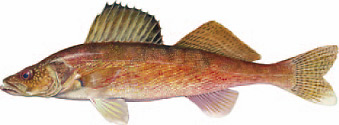 Scientific Name
Scientific Name
Sander vitreus
Other Common Names
walleyed pike, jack
Identification
Largest member of the perch family (Percidae). Grows up to 21 inches, 3 and 4 lbs. by age three. Brassy-olive sides flecked with green and gold, and mottled by 6 to 8 obscure marking on top, white belly. Dorsal fins completely separate and unmarked, except for a distinct dark blotch at the rear base of the front dorsal fin. White blotch on tip of lower tail fin. The eye has a milky cornea, hence the name walleye.
Best Fishing
Lakes: Flannagan, South Holston, Gaston (especially below Kerr Dam), Leesville, Philpott, Chesdin, Anna, Whitehurst, Orange, Hungry Mother, Burke, and Brittle. Rivers: New, Staunton/Roanoke, South Holston, Clinch, Dan.
Fishing Techniques
Jigs dressed with plastic grubs or tipped with live bait work well, especially in cold water. Three to five-inch minnow plugs are very effective when walleyes move into shallow water. Crankbaits and jigging spoons work well when walleyes are deep. Trolling with nightcrawler harnesses (spinner rigs) is the preferred method in reservoirs during the summer months. Live baits such as minnows, shad or nightcrawlers are always a good option for walleye.
Feeding Habits
Avoids bright sunlight, choosing to lie in deep or shaded cover during the daylight hours. Moves onto bars and reefs near the shallows to feed at night. Natural foods include small fish, insect larvae, crayfish and other aquatic animals. In some cases, they will be active during daylight hours if its overcast or the lake is turbid to cut down light penetration.
Habitat
Native to the Tennessee and Big Sandy River drainages, which includes the Clinch and Holston Rivers in Virginia. Prefers waters that are cool. Have been widely introduced into lakes. Orients next to ledges, large rocks, underwater islands, large logs, edges of large beds of aquatic vegetation, along old riverbed channels, along reefs and bars.
Spawning Habits
Spawn as early as late-February, as water temperatures get into the upper 40s and lower 50s. Normally run rivers to spawn but they will spawn in lakes over rocky or gravel shoals, or amid clean, low-growing emergent vegetation. Eggs are non-adhesive and unattended after being released. They hatch in about two weeks.


